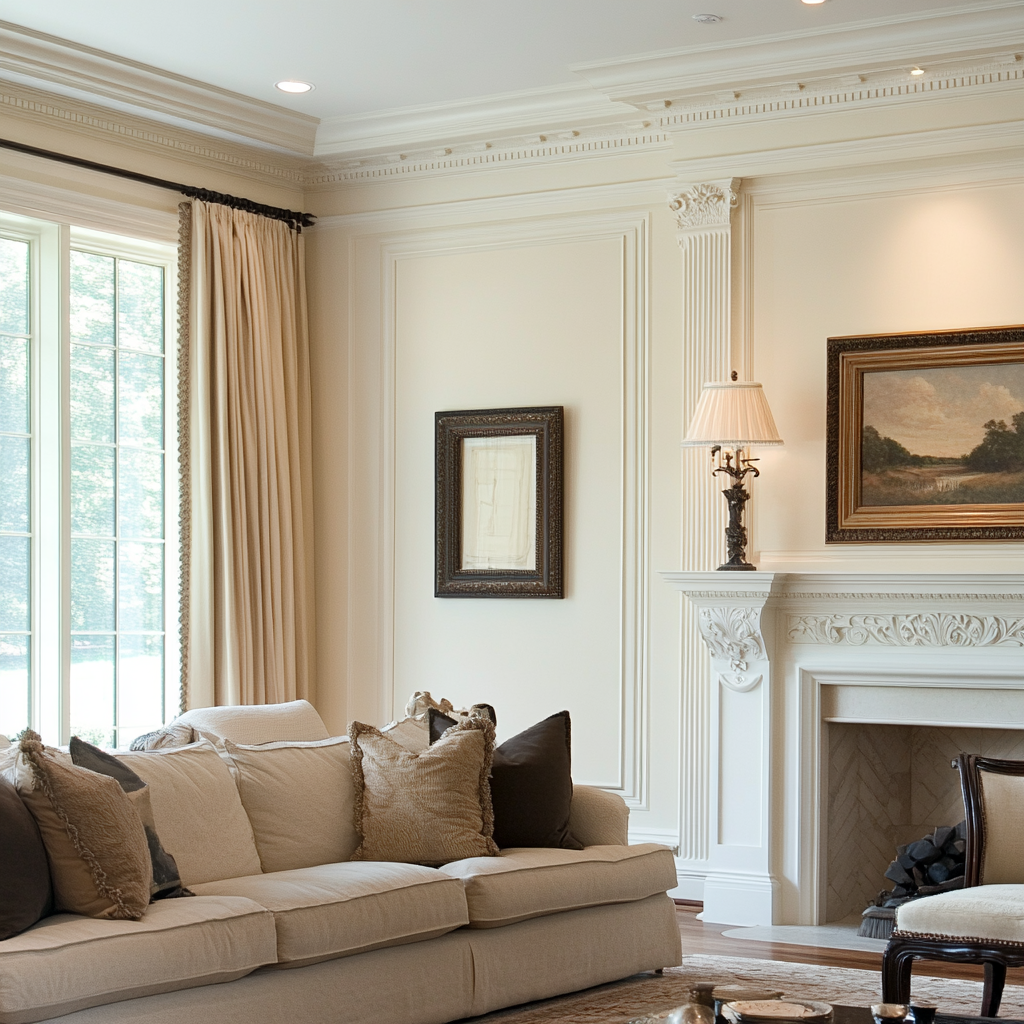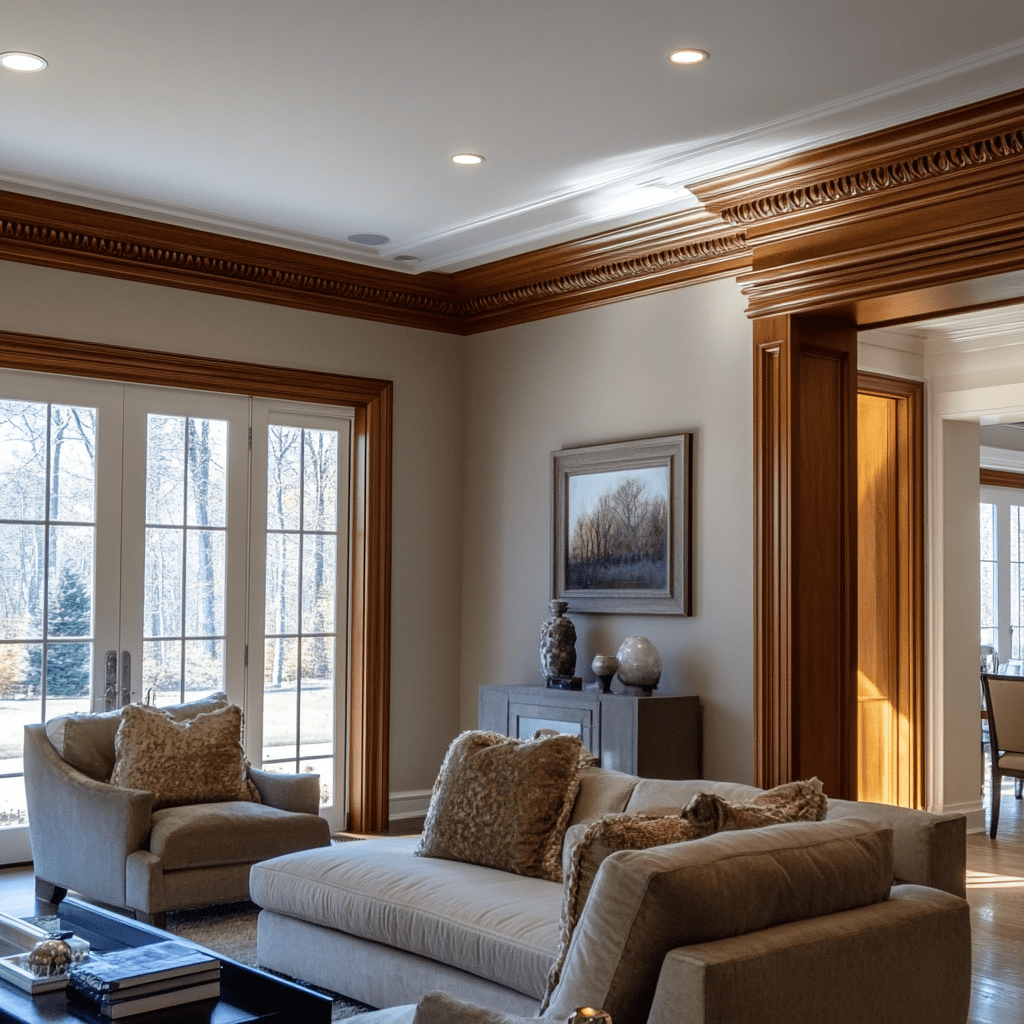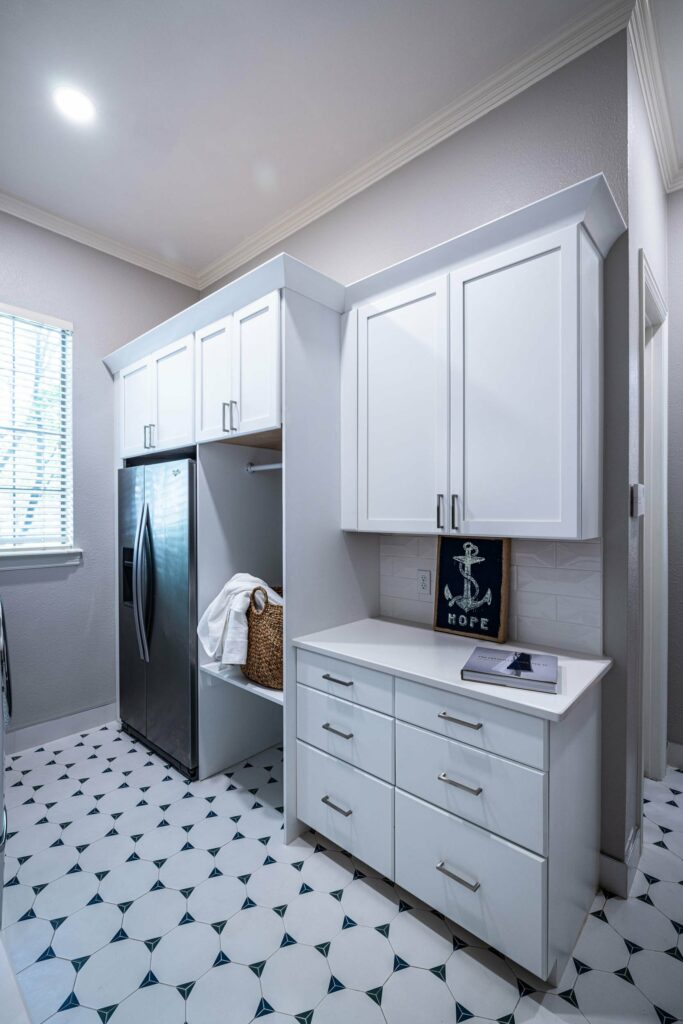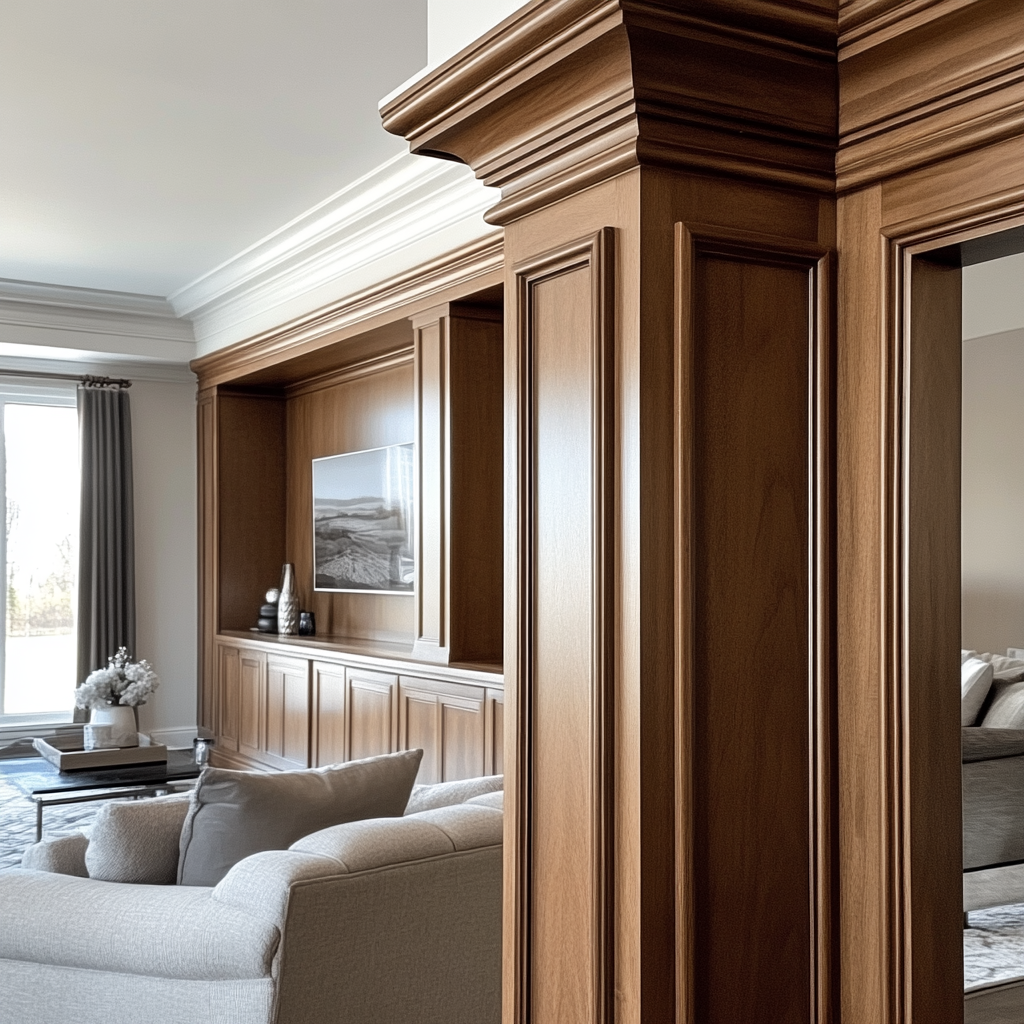
Interior molding—or trim—is one of those design elements you don’t always notice at first glance…
But once you do, you can’t unsee it. It frames a space, highlights architectural details, and creates seamless transitions between rooms.
Without molding or interior trim, a room can feel visibly unfinished. (ESPECIALLY with the maximalist and traditional-inspired environments we see today!) But if you’re sitting here asking, “what types of molding are there,” the answer isn’t as simple as listing a few styles. Trim can actually be categorized in THREE different ways:
- By design style
- By its placement in a room
- And by material
Each gives you a different perspective on how trim contributes to the overall look and function of your space. Let’s break the types of trim down in the most practical (and stylish) way possible!!
Interior Molding by Design Style
The first way to define interior types of molding is by design style. Some styles are classic, some are ornate, and some are sleek and modern. Each brings a different personality to a room.
Which is the personality you want to showcase?!

- Traditional molding – This is the “gold standard” for interior molding. Traditional trim features different series of elegant curves with crisp lines, and it instantly elevates a space. It’s your go-to selection for timeless interiors.
- Egg and dart molding – A majestic selection, this trim style features repeating oval (egg) and arrow (dart) patterns. This one comes straight out of Greek and Roman architecture!! Talk about a perfect selection for anyone craving a little grandeur…(and see how classic architecture affected today’s color palettes in interior design, too).
- Dentil molding – If small and evenly spaced rectangular blocks set along the length of trim sound familiar, then you’ve seen dentil molding. This intricate style is synonymous with stately homes and unassuming elegance.
- Cove molding – This type of interior trim has a gentle curve that softens the transition between ceiling and walls. Called cove molding, it’s a great way to add character without ostentation.
- Leafy or ornamental molding – This is the botanical-inspired trim style that brings natural motifs indoors. (Hello, biophilic interior design!) Think carved leaves and vines, and that’s the molding that adds a touch of the outdoors inside…
- Modern and minimalist – With sleek lines and little to no ornamentation, this type of trim creates definition without drawing attention to itself, making it ideal for the most modern interiors.

Molding By Placement

Where and how trim is installed changes what it’s called. If you want to understand what is molding in a house, there are more answers than you think!!
Though some of these trim types overlap, the purpose and installation is what will guide you on incorporating molding into your next renovation.
- Crown molding – This is the star of trimwork!! Crown molding sits where the walls meet the ceiling, right at the joint, creating a polished and often dramatic finish. Taller styles make ceilings feel higher, while simpler designs add just the right amount of detail…
- Baseboards – These are the foundation of a room’s trim. Baseboards cover the joint where walls meet the floor, preventing scuffs and adding a finished, refined look. Taller baseboards can make a room feel more luxurious, too.
- Chair rails – Originally meant to prevent chairs from scuffing walls, chair rails are a thin trim type installed right at chair height around a room. They also serve as a decorative divide that adds dimension. These are often seen with wainscoting.
- Wainscoting – More than just molding, wainscoting is paneling framed by trim. It usually covers the lower half of a wall and gives the room a rich, traditional look. Picture it…the perfect historical southern home…and the walls are lined with panels, each with trim around them. You know what I’m talking about!! (And now you know what it’s called!)
- Picture rails – Positioned right below the ceiling (several inches below the crown molding), this horizontal trim was historically used to hang artwork without damaging walls. How clever! Today, it’s just as much about aesthetics as function.
- Picture frame molding – Now this type of trim is not for actual picture frames!! It’s a decorative trim installed directly on the walls to mimic paneling or to create an artistic focal point…
- Door and window casing – This is the trim that outlines doors and windows, creating a finished look while hiding gaps between frames and walls.
- Plinths – And, as long as we’re talking about types of trim for doors, plinths are the block-like details at the base of door casings that add a subtle architectural flourish to your entrances.

Molding by Material
The materials used to make trim differ, too, and that’s the third way you can define “types of trim.” The materials you select affect EVERYTHING from durability to cost to how the trim is installed.

Here’s a look at the most common materials used for interior molding…
- Solid wood – This is the classic choice for interior molding!! Natural wood adds warmth and character, can be stained or painted, and offers unmatched authenticity. However, it expands and contracts with humidity…which makes a big difference in something like trim, where everything is cut and sized “just so.” This means your wood trim MUST be treated and installed correctly.
- Polyurethane – A more economical alternative to plaster or wood, polyurethane resists moisture, rot, and pests. It’s ideal for detailed styles like egg and dart or dentil molding where damage could completely undermine the integrity of the design.
- PVC – Polyvinyl chloride, or PVC, is the go-to for bathrooms and humid environments, and it’s easy to see why! PVC trim is completely waterproof. Its smooth surface does require a good primer before painting, though.
- MDF (Medium Density Fiberboard) – Another economical alternative to wood, MDF trims are fine when they’re given painted finishes, but should be kept away from moisture-prone rooms.
- Flexible molding – This is a rather unusual alternative, but it’s worth mentioning to give you the full glossary of all the interior molding terms you need!! Flexible molding is made of a pliable material that bends around curved walls and unique architectural features. This can be a design-saver for non-standard spaces!

Interior molding might seem like a small detail, but it holds a room together in a way that NO other design element does.
Are you aiming for timeless elegance? Modern simplicity? Or something that stands out and says something about YOU? Understanding the different styles, placements, and materials used in interior types of molding will help you make the right selection.
Now that you know the many ways to classify molding, you’re ready to add that perfect finishing touch to any space. Here’s how to look at your space and select the right interior types of molding for your home.
About the author:

Robin Burrill, RID, NCIDQ, ASID, IDS, CAPS, is an award-winning professional kitchen, bath, and interior designer. Robin and her husband, Robert Mathews, have owned Signature Home Services, Inc. for nearly three decades, establishing a superior in-house team with a widespread reputation for delivering meticulous design to their many repeat clients.
In 2022, the national publication, Kitchen and Bath Design News magazine, named Robin to their Top Innovator list in recognition of her achievements in the field of kitchen and bath design. In 2024, she was named one of the Fall 2024 Market Pros and “tastemakers” by ANDMORE at High Point Market. Also in 2024, Fixr identified her as one of the Top Professional Interior Designers for their nationwide audience. At the start of 2025, she then acted as one of Dallas Market’s “Style Eyes” at Lightovation and Total Home & Gift Market.
Over her extensive career, Robin has been quoted in Architectural Digest and Forbes multiple times; her design work has been featured in top national trade publications; and she has been interviewed for Designers Today magazine’s “Profiles in Design” video series, among others. Widely respected for the depth of her knowledge, Robin is a sought after speaker and judge for many design industry events.
In 2023, Robin designed a bench for Charleston Forge, making her foray into product design. Robin currently serves as a volunteer on the board of the Dallas/Ft. Worth chapter of the Interior Design Society.

